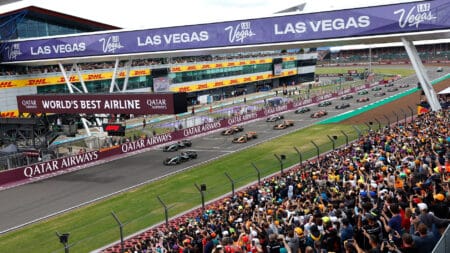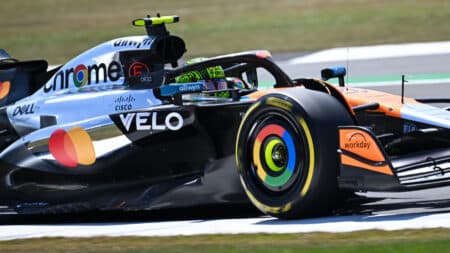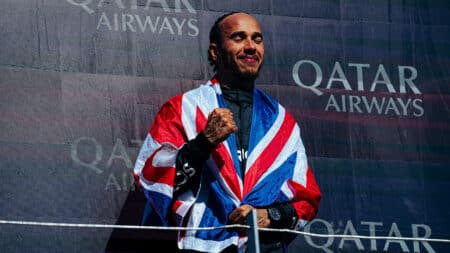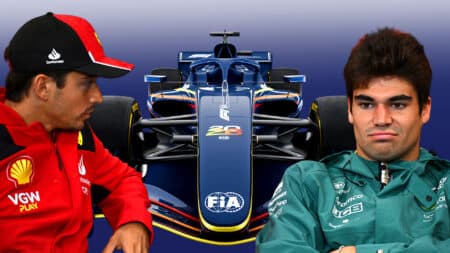
Tomorrow's F1 starting grid for the 2025 British Grand Prix
Max Verstappen will start on pole for the 2025 British Grand Prix after a brilliant last gasp qualifying lap. Here's how the starting grid looks for Sunday's race at Silverstone
I frequently find myself straddling F1’s past and present in my writing. For Motor Sport my current assignment is to bring you all that’s happening in present day F1, in racing terms, technical and political. But in other projects, such as a forthcoming book I’m hoping to have published about the 1980 season, I’m looking back in time. This dual perspective frequently emphasises the threads that connect past to present. As F1 currently struggles to encompass a workable business model, the 1980 season was arguably the first when this became a real point of contention. Below is an extract from the as-yet unpublished work, giving a reminder of the 35-year-old roots of the current situation.
Bernie’s world was becoming evermore central to F1’s. Nine years in, he was out-growing the role of team owner. In that time he’d transformed the way the whole business operated, putting the teams – rather than the circuits or the governing body as it had traditionally been – in the driving seat, and him at the wheel. He’d banded together the British teams – the garagisti as Enzo Ferrari contemptuously christened them – that comprised the majority of the grid and negotiated on their behalf with the circuits for the terms of their group appearance. The tracks no longer held the teams to ransom in negotiations, playing one off against the other.
The transition to an entirely new business model, an amateur sport being dragged screaming and kicking into the commercialised world of the late 20th century, had been sudden and was still changing fast, as TV companies rolled in – their terms negotiated through Bernie. The ostensible governing body, the FIA, with its palatial Paris offices and committees of blue bloods, seemed at real risk of becoming obsolete, simply by-passed by commerce. Enter Ecclestone’s nemesis in the fabulously bombastic form of Jean-Marie Balestre (below with Max Mosley). Elected as President of the FIA the previous year, he had vowed to loosen Ecclestone’s increasing grasp and return to the sport to its rightful owner, the governing body.
But actually no-one really owned it. Only the recent increasing flow of money from the TV deals had even defined the question of ownership. In keeping with the coming ethos of the ’80s, F1 was suddenly being monetised. Whether that was a crass mentality polluting a hitherto pure sport was a largely irrelevant question. With the industrial base of the west beginning a long, slow decline the commercial potential of everything was coming under intense scrutiny – even things that had never previously been much associated with profit. F1’s transition was just part of what would increasingly be happening everywhere in the coming decade.
It was a more crass time than a decade earlier, something that was reflected aesthetically in the harsher colours and fashions, the slap-it-on-with-a-trowel look of the circuit ads and car liveries, the increasing homogenisation of the backdrops as safety legislation imposed its dictates. The sport of it all, as opposed to the show, was less visible than before though still much more apparent than it would become. F1 at this stage in its evolution was in the early stages of puberty; no longer innocent, and looking to be less so, but still endearingly naïve when looking back. But from the inside – whether that be from Frank’s old carpet warehouse, Gordon Murray’s drawing board or the cockpit of Gilles Villeneuve’s Ferrari – all that stuff was irrelevant. How the sport was perceived was only for those looking in from the outside – the fans, mostly. Inside, in the intense competitive endeavour of it all, in the playing of the game to its maximum, it was as beautiful as it had ever been.
But in 1980 the participants were being jolted out of their idealised worlds, forced to choose sides as Balestre and Ecclestone (with the help of his legal advisor, the former March team owner Max Mosley) locked horns over who controlled F1 and its increasing income. Commercially, this was still the wild west, with possibly vast future rewards for those who successfully staked their claim. Ecclestone had seized the commercial initiative on behalf of himself and the teams he represented (which comprised over 70% of the grid), carving up the TV money and race hosting fees. In response, Balestre used the most potent weapon in the FIA’s armoury – its power to change the technical regulations.
In doing this, Balestre was exposing the natural fault line in Ecclestone’s potential territory – which was that the factory teams Ferrari, Renault and Alfa-Romeo had no wish to be part of a group of questionable legitimacy that had only been formed to serve the specific interests of small, specialist racing constructors. Furthermore, they had a natural distrust of the operator Bernie. They were naturally more aligned with the traditional formal sporting authority of the governing body.
Balestre was not slow to prise that fault line apart by provocatively favouring the factory teams in his proposed changes to the technical regulations for 1981. Increased minimum weight and a ban on sliding skirts favoured the turbos (and all three factories had F1 turbo engines under development by 1980, though only Renault so far was racing them) and legislated against ground effect aerodynamics (the mastery of which was the small British teams’ chief weapon against the increasing power of the heavier turbo cars). It could hardly have been more adversarial and it laid out the battle ground very clearly.
The FOCA teams (as Bernie’s band of British independents was known) could see a very explicit threat to their future. They were far too small to contemplate the massive investment needed to create their own engines and this was not within their range of expertise anyway. But the factory turbos of Renault and those certain to follow them suggested a potentially huge performance advantage once the technology matured. Were the specialist British teams about to be turbo-boosted out of existence of a sport set to become a playground for the road car industry?
They needed to be militant, absolutely had to stand together – in a tight line behind Ecclestone. It’s easy to imagine the attitude of Frank Williams – a staunch British patriot – towards the French body that was trying to take away his prospect of long term success just as he was finally beginning to achieve it after over a decade of struggle on the margins. Colin Chapman, Ken Tyrrell, Ecclestone himself, McLaren’s Teddy Mayer and others were potentially staring at a similarly stark future if the big factories returned in force. No ground could be conceded; they were fighting for their future survival.
Balestre’s long term end game was pretty obvious; deprive the FOCA teams of their oxygen of performance. As they became regulated out of competitiveness so their bargaining power would wane, even more so as waves of big factory turbo teams arrived, and the governing body would assume full control once more – commercially and technically.
The reality was that the small independents were the glue that held F1 together, arguably the only reason the category still existed for the factory teams to plunder every time the whim took them, only to then leave for another decade or so. A cycle of boom and bust was how it had been throughout the history of grand prix racing, right back to the first mass manufacturer pull-out at the end of 1908 – until the British ‘garagisti’ sprung into life in the 1950s by historical chance. Independent teams designing their own advanced chassis around bought-in engines, gearboxes and all manner of other mechanical components established a robust network that finally gave grand prix racing a strong skeleton, making it immune from the whims of the manufacturers. That network was now the base of Ecclestone’s power and in threatening the latter Balestre was also putting at risk the former.
Balestre and Ecclestone were therefore cast in elemental roles in an epic struggle for the sport’s future, with wildly different respective visions of how it would look, and 1980 was when the war finally broke out. Ecclestone: brisk, neat, understated, astute and with not the slightest trace of vanity, ruthless moves made below the radar. Balestre: volcanic, illogical, theatrical, vain, in rapture to the sound of his own oratory – but not without a certain naïve nobility of purpose; he may have been strutting his feathers as he did so, but he was fighting for what he believed was right. In doing this he single-handedly transformed the FIA from a passive, moribund body, there only through the habit of history, to an assertive, thrusting, even authoritarian, regime.
The scalpel and the sledgehammer, their possible pasts were impossibly colourful, stories that may or may not have been true. In keeping with their characters, Bernie played his down, Balestre built his up. Was Bernie the never-caught brains behind the Great Train Robbery of 1963? Was that how he returned to the sport in the ‘60s as Jochen Rindt’s manager a lot wealthier than when he’d left it in the ‘50s following the fatal accident of his friend Stuart Lewis Evans in the ’58 Moroccan Grand Prix? “No, I would never have been in charge of something so disorganised,” he’d reply. “If I’d been in charge it would have been done properly.”
Balestre claimed to have fought in the Spanish Civil War against Franco’s forces. Had he? He said the reason there existed World War Two pictures of him in Nazi uniform was because he was acting as a French Resistance agent. Was he? Certainly, he seemed like a man looking for wars to fight. Bernie, rather like his driver Piquet, preferred to sidestep conflict and proceed directly to higher ground. The ghosts of their past truths shimmered ungraspable between the legends, mirrors and smoke but were largely irrelevant now when the only truth of consequence was their respective power and their alignment against the other.

Max Verstappen will start on pole for the 2025 British Grand Prix after a brilliant last gasp qualifying lap. Here's how the starting grid looks for Sunday's race at Silverstone

Austrian GP winner Norris went quickest at Silverstone during the Friday F1 practice sessions ahead of the 2025 British Grand Prix

Lewis Hamilton hadn't won in almost three years – and then produced a sensational victory at Silverstone 2024. James Elson explains why it was his best ever

As more drivers get a feel for the 2026 Formula 1 cars in simulators, concern is growing that the new regulations may sacrifice driving enjoyment in pursuit of technical ambition, as Mark Hughes reports